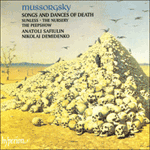
Welcome to Hyperion Records, a British classical label devoted to presenting high-quality recordings of music of all styles and from all periods from the twelfth century to the twenty-first.
Hyperion offers both CDs, and downloads in a number of formats. The site is also available in several languages.
Please use the dropdown buttons to set your preferred options, or use the checkbox to accept the defaults.

| Anatoli Safiulin (bass), Nikolai Demidenko (piano)» More |
Numerous sources refer to Mussorgsky’s liking for and affinity with children. Varvara Komarova-Stasova (niece of the influential critic Vladimir Stasov) remembers meeting the composer when she was a child of seven: she later recalled that ‘since he did not strike a pose with us and did not speak to us in that artificial language ordinarily used by adults with children … we began to consider him one of us. Kot Matros was one of a few songs he wrote that represent stories of our childhood.’ So Mussorgsky had brought the historical and theatrical realism (for which he became known in his operas) into everyday life by depicting, in music and words, scenes that he may have actually witnessed. The style of the songs is varied but typical of that of Mussorgsky’s maturity; he derived his language not only from folk music and the russkaya pesnya, but also from the romans, and from the Romantic masters of western European music such as Liszt. In his quest to discover the musical equivalent for the patterns, inflections and cadences of spoken Russian, Mussorgsky created eternally fresh yet haunting tableaux of domestic life.
from notes by Jonathan Powell © 2004
De nombreuses sources rapportent combien Moussorgski se sentait proche des enfants. Varvara Komarova-Stasova (nièce de l’éminent critique Vladimir Stasov) se rappelle sa rencontre avec le compositeur alors qu’elle avait sept ans: loin d’adopter ce langage emprunté avec lequel les adultes parlent souvent aux enfants, il fut très naturel avec nous. Si naturel, que nous commençâmes à le compter parmi les nôtres. Kot Matros était l’une des rares chansons qu’il écrivit lui-même, et qui dépeignent des histoires de notre enfance ». On le voit, Moussorgski importa le réalisme historique et dramatique (si caractéristique de ses opéras) dans la vie de tous les jours, en décrivant, en paroles et en musique, des scènes dont il était le témoin. Le style des mélodies varie, mais il est typique de la période mûre du compositeur; il tirait son langage non seulement de la musique populaire de l’époque et de la russkaya pesnya, mais aussi des romans, et de l’inspiration des grands maîtres romantiques de la musique européenne, tels que Liszt. Dans sa quête de la découverte de l’équivalent musical des motifs, des inflexions et des cadences du russe parlé, Moussorgski créa des tableaux frais et à la fois obsédants de la vie quotidienne.
extrait des notes rédigées par Jonathan Powell © 2004
Français: Marie Luccheta
Obwohl Mussorgskij zu Beginn des Jahres 1869 die Stelle des stellvertretenden Leiters der Forstwirtschaftabteilung des Ministeriums für Staatseigentum angenommen hatte, gelang es ihm trotzdem, gegen Ende des Jahres die erste Fassung seiner monumentalen Oper Boris Godunow abzuschließen. Im Herbst des darauf folgenden Jahres schrieb er die meisten Lieder, aus denen sich die Kinderstube zusammensetzt. Als Die Kinderstube im Juni 1872 bei Bessel im Druck erschien, hatte der Komponist noch ein älteres, 1868 komponiertes Lied, S njanej („Mit der Njanja“) hinzugefügt. Zwei weitere Lieder—Kot Matros („Der Kater Matrose“) und Pojekal na palotschke („Steckenpferdreiter“) – wurden später im Jahr 1872 beendet und separat veröffentlicht. Die Kinderstube wurde zu Lebzeiten des Komponisten Mussorgskijs bekanntestes Werk. Man erzählt sich sogar, dass die damals berühmte Sopranistin Aleksandra Molas die Sammlung in einem ihrer Konzerte aufführte. Duzende Exemplare des Stücks wurden danach im Laden von Bessel verkauft.
Zahlreiche Berichte dokumentieren Mussorgskijs Interesse an und Zuneigung zu Kindern. Warwara Komarowa-Stassowa (die Nichte des einflussreichen Kritikers Wladimir Stassow) erinnert sich an ein Treffen mit dem Komponisten, als sie sieben Jahre alt war. Sie erzählte über Mussorgskij später das Folgende: „ … weil er sich nicht wie ein Erwachsener aufführte und zu uns nicht in dieser künstlichen Sprache sprach, die von Erwachsenen gegenüber Kindern gern angewandt wird … , begannen wir ihn als einen der Unseren zu betrachten. Kot Matros war eines seiner diversen Lieder, die Geschichten von unserer Kindheit erzählten“. So brachte Mussorgskij den historischen und szenischen Realismus (für den er in seinen Opern berühmt wurde) in das alltägliche Leben, indem er in Wort und Musik Situationen abbildete, die er vielleicht selbst erlebt hatte. Stilistisch unterscheiden sich die einzelnen Lieder voneinander, aber alle sind typisch für den reifen Mussorgskij. Für seine Musiksprache erhielt er nicht nur Anregungen von der Volksmusik und dem russkaja pesnja, sondern auch von der romans und den europäischen Meistern des 19. Jahrhunderts wie Liszt. Auf seiner Suche nach musikalischen Entsprechungen für die Phrasierung, Sprachmelodie und Kadenzierung des gesprochenen Russischs schuf Mussorgskij ein anhaltend frisches wiewohl auch beklemmendes Tableau des häuslichen Alltags.
aus dem Begleittext von Jonathan Powell © 2004
Deutsch: Elke Hockings
 Musorgsky: Song Cycles Musorgsky: Song Cycles'El bajo Safiulin nos ofrece una interpretación variada, sutil e interiorizada' (Ritmo, Spain)» More |

